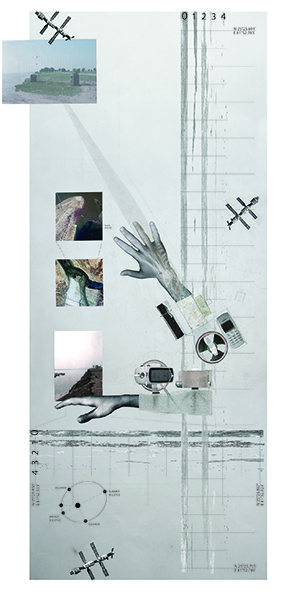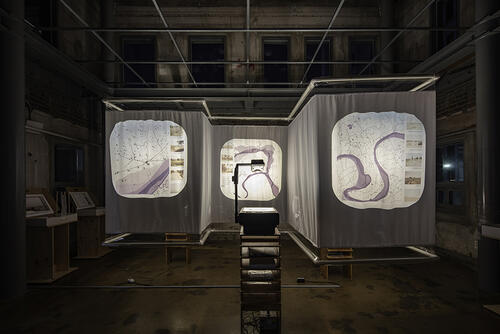Anthony Acciavatti is the Diana Balmori Assistant Professor of Architecture at the Yale School of Architecture and a member of the South Asian Studies Council.
Can you tell me a little bit about yourself, what you do, and how you ended up at Yale?
I am trained in architecture, geography, and history of science. I studied architecture at Rhode Island School of Design and Harvard, history of science at Princeton, and I was a Fulbright Fellow in the Department of Geography at the University of Allahabad.
I first came to Yale through the South Asian Studies Council’s Modern South Asia Workshop to share a chapter from my dissertation. I eventually had the good fortune to come back as a fellow in the Agrarian Studies program that Professor K. Sivaramakrishnan and Professor James Scott, now retired, co-directed.
One of your books, Ganges Water Machine, deals specifically with the landscape of the Ganga and how it’s been modified over centuries. I’m curious how you got interested in South Asia as a field of research and for work.
I don’t have a very persuasive or compelling reason for how it happened other than to say that I had lived in New Orleans for a time, grew up not far from the Mississippi, lived in Rome along the Tiber, and developed a romance for rivers and cities. As I was cresting into my final semester of undergrad, I knew I wanted to study a major river basin for an extended period. I looked at the Ganga, the Amazon, and the Nile. All three river basins are incredible, but the Ganga’s population density, agricultural productivity, and the monsoons just really drew my attention. I wanted to know as an architect how people choreograph themselves in relation to these changes and coauthor space. In 2005 I was awarded a Fulbright Fellowship to undertake this research. I thought this would take a year to do, but it took a decade. That’s how I fell into it. It was serendipitous.
Ganges Water Machine consists of visual representations of the landscape of the Ganga. What do you find interesting about cartography?
Part of what I’m interested in with cartography is not its objectivity in terms of measure but its subjectivity of measure. That’s why I made instruments that I would wear, and prosthetics to do this work: because I was interested not in the map being the definitive object that gets done but in it being in a constant state of being made and remade.
When we think of a map, with all its precise lines and borders, it’s usually like couture fashion. Like clothing made for a wedding, it’s tailored for a particular person at a particular point in time. However, if you gain a few kilos, lose a few, it doesn’t quite fit. But my maps are more like ready-to-wear. They’re very similar to what you get at Big Bazaar or H&M. Gain a few kilos, lose a few kilos—it still fits, because it has what you call in apparel a seam allowance. The drawings that I make are also meant to be understood in terms of how they start to render change, not constrict it or push it out of the space of the map.
Along with making maps and instruments to write histories of the Ganga basin, I also make exhibitions and organize workshops. Recent exhibitions include “Rivers of Life” at Azim Premji University in Bengaluru, where I also gave a virtual talk on the virtues of seeing like a mudskipper, as well as exhibitions at the Milan Design Triennial and the Seoul Architecture Biennial.

Anthony Acciavatti, Surface Accumulation Sleeve (to undertake soil particle size analysis and conduct an ethnography of soil)
Could you speak a little about Republic of Villages, your forthcoming book?
It’s a history of devising the visual pedagogy for a largely non-literate population in South Asia from the 1880s through the 1970s. What it looks at is the way in which so many of the people who were calling eventually for independence, for modernizing, for industrializing (in very different ways), especially in what would become India, were convinced that in this polyphonic landscape, it might be possible to develop a mono-visual culture, and that if you could communicate with such vastly different groups of people with no common language, religion, or sense of nationhood, that it might be possible to persuade them to be part of a larger nation-building project at the village level. At the time of Partition/independence in ‘47, there were 558,000 villages in India alone and roughly 80% of the population lived there. Especially once Mao Zedong comes into power in 1949, and then forms what becomes the PRC, there’s a real concern from Washington, D.C. to New Delhi and even to Moscow about what a peasant revolution might look like in other parts of the world. So, there’s an increasing desire by a lot of very different, politically diverse people to be involved with the village. I trace the history of this visual pedagogy from the 1880s in Calcutta and conclude with Indira Gandhi’s Emergency in the 1970s.
I started working on this back in 2012. Try as I might to be more Soviet or Indian in developing projects along five-year plans instead of ten-years, I just can’t do it yet.
Anything you’d like to say about your teaching?
I teach a class called Labs and Landscapes of the Green Revolution in the spring. Along with weekly readings and assignments that involve eating and cooking, we will travel to one of the major laboratories and landscapes of the Green Revolution: India. The final project will be a collective cookbook of the Green Revolution. I taught the class last year, and while we didn’t get to travel, we did make a cookbook. Each entry focused on one of five crops integral to this color-coded revolution. From these ingredients we unraveled histories of taste, international development, technical exchange, environmental degradation, and much more. This was a multi-disciplinary undertaking, with students from the School of Architecture, the School of the Environment, the Jackson School, as well as Yale College. Projects spanned the globe, from Asia to Europe and from Africa to the Americas. While I edited the cookbook, and the students created the entries, we worked with two graduate students in graphic design in the School of Art. Needless to say, I’m looking forward to traveling to India so that students see these sites and discern the lingering legacies of the Green Revolution today.


